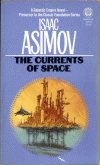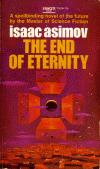It is obvious after the first few chapters that this novel is on a whole different level than “The Stars, Like Dust.” There are more characters, deeper development, and various plot lines are explained through flashbacks. It seemed like Asimov spent a lot more time on this book than the last one. It is just a tad bit longer at 230 pages in my paperback copy, but quite bit more happens. There is still the medieval feel with Sark ruling Florinia and the various class struggles that go with that.
The book prologue starts out with a conversation between a spatio-analyst from Earth and another unknown man about the eminent destruction of the planet Florinia which is controlled by the planet Sark. After questioning the delays in warning Sark and the Florinians, the spatio-analyst finds himself drugged and on the wrong end of a psychic probe.
Rik, the psycho-probed spatio-anlalyst, was reduced to a babbling idiot and dumped on the planet Florinia. After a period of recuperation, he gains enough skills to be somewhat productive. One year later while working at a kyrt factory on Florinia his memories start to return. This marks the beginning of an action packed adventure. Florinia is the only place that a special fiber called kyrt can be grown, which has many uses from clothing to space travel. Efforts have been made to transplant this product to other worlds, but with no success. The Trantorian Empire, which controls about one half of the inhabited worlds, would like to control over this monopoly over the kyrt trade which Sark enjoys.
Valona, which has been given the responsibility of keeping Rik out of trouble, immediately takes her friend to the Myrlyn Terens, the Townman in charge of their village. All Rik can seem to remember is that he “analyzed Nothing” and that that Florinia was in extreme danger. The Townman takes Rik to the library to hopefully jog his memory when they find out there is a special hold on all texts related to spatio-analysis. This spooks the Townman and as he tries to get Rik out of the library they are stopped by a Patroller. Valona comes out from nowhere and knocks the Patroller out and suddenly the three of them are on the run.
This opening sets up quite bit of mystery which gets deeper as the novel progresses. Some of the flashbacks get a bit confusing a times because sometimes there really isn’t any transition between the present and the past. I found in many cases I wasn’t sure what time frame the story was in until a few paragraphs later. Aside from this annoyance, the flashbacks offer a good way to develop the new characters that are constantly being added throughout the novel. Again, I’m amazed at how little of the plot I remembered from reading this several years ago. I’m glad to say that I enjoyed this quite thoroughly for a second time.




Just finished reading this and really, really enjoyed it. I read a few pages before bed last night and then picked it up first thing this morning and couldn’t put it down until I was done with it. Great fun.